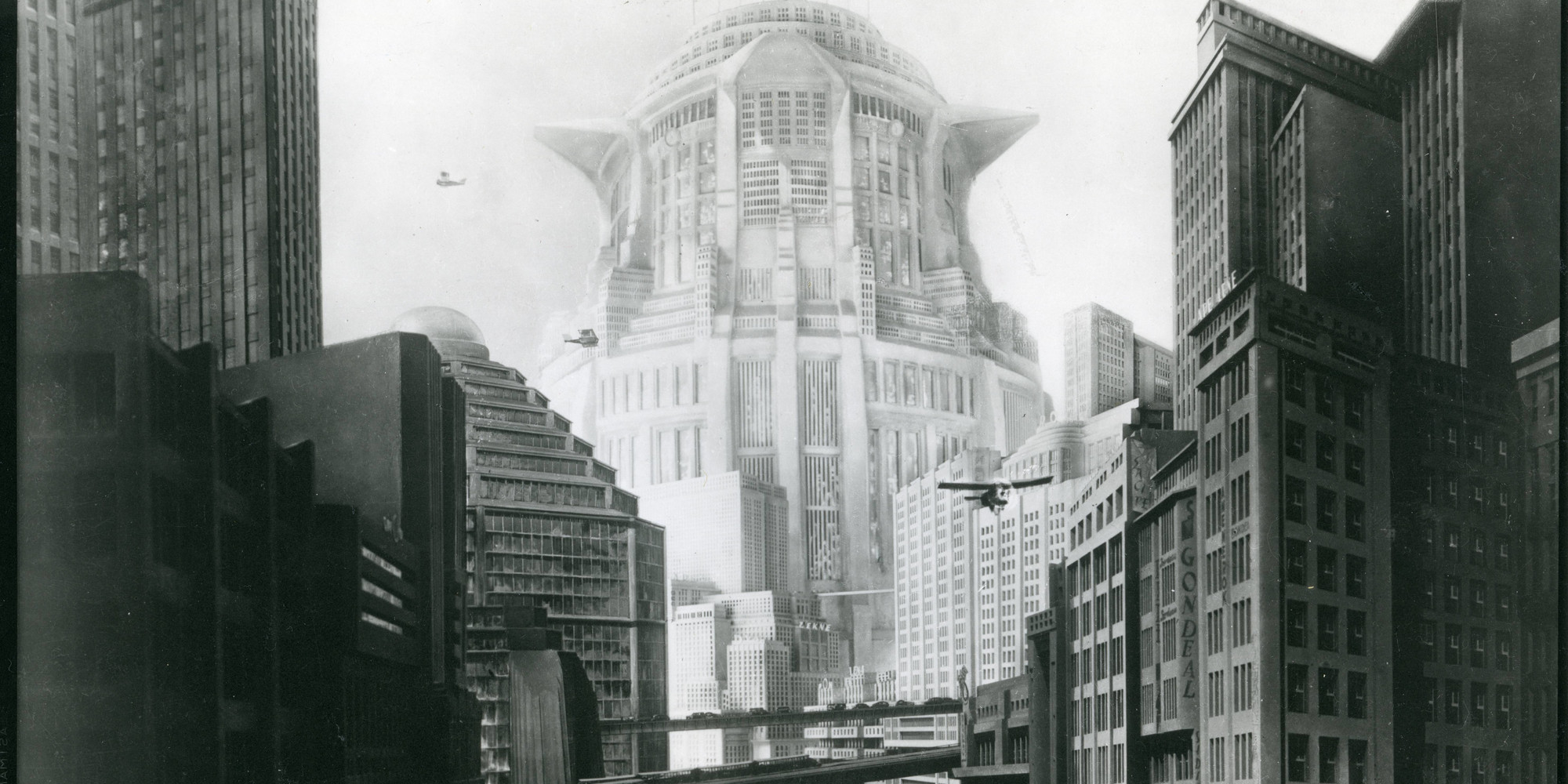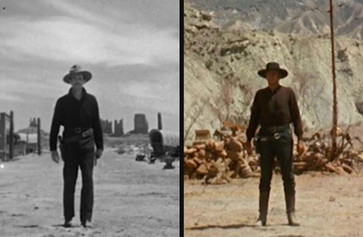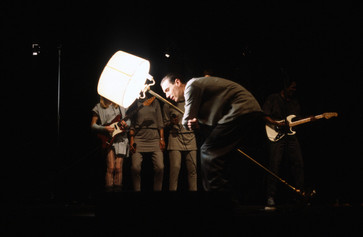
Building Worlds: Movie Recommendations from MoMA’s Department of Architecture and Design
From Jacques Tati to Clueless, they’ve shared a bevy of films in which architecture and design are the stars.
Apr 1, 2020
Films are available to stream for subscribers where indicated. All films are available to rent on major platforms.
Martino Stierli, Philip Johnson Chief Curator of Architecture and Design
Metropolis. 1927. Germany. Directed by Fritz Lang
Criterion Collection
With its bold futuristic vision of a city yet to come, Metropolis is perhaps the mother of all cinematic urban utopias, including Ridley Scott’s Blade Runner (1982, see below). Set in this spectacular stage set, this classic Weimar Republic movie tells the love story between a son of the city’s ruling class and a working-class prophet. The social tensions portrayed in the rise of an industrial society speak not only to that historical moment but also to our current situation of increasing economic inequality.
Man with a Movie Camera. 1929. USSR. Directed by Dziga Vertov
Dziga Vertov drew on experimental montage technique for his daylong portrait of urban life in the Soviet Union, showcasing every aspect of modern life, from work to transport and leisure, in what is considered one of the most innovative and influential films of the silent era. The boundaries between man and machine become blurred, and the movie camera is seen as an extension of the body. An excerpt of this movie is included in the Vertical City gallery on MoMA’s fifth floor.
Playtime. 1967. France. Directed by Jacques Tati
Criterion Channel, Kanopy
Jacques Tati’s masterpiece sees the loveably clumsy Monsieur Hulot thrown into—and trying to manage—a modern world characterized by postwar corporate capitalism, anonymity, and steel-and-glass architecture. The movie is both comedy and critique of the modern human condition. An excerpt of the film is included in the Architecture Systems gallery on MoMA’s fourth floor.
Evangelos Kotsioris, Curatorial Assistant
The Electric House. 1922. USA. Directed by Edward F. Cline and Buster Keaton
YouTube
Electricity promised to modernize every aspect of domestic life in the beginning of the 20th century. This short comedy film, written and codirected by Buster Keaton, cautioned that the gadget-wiring of any house should only be performed by accredited electrical engineers. Otherwise, mayhem may ensue.
Mon Oncle. 1958. France. Directed by Jacques Tati
Criterion Collection
Suburban life never looked as streamlined as in Villa Arpel, a starkly modern, colorful, and mechanized house outside Paris in the late 1950s. The amicable Monsieur Hulot and his nephew Gérard Arpel, whose parents inhabit the house, embark on a series of adventures inside and outside that consider the promises and failures of modern design.
Koolhaas Houselife. 2013. France. Directed by Louise Lemoine & Ila Bêka
Vimeo on Demand
A day in the life of Guadalupe Acedo, the housekeeper of Maison à Floirac in Bordeaux, offers a rare and hilarious insight into one of the most celebrated examples of contemporary architecture. Seen through the eyes of Acedo and her labor of maintenance, the hydraulic platform-equipped house designed by OMA/Rem Koolhaas reveals its human side and endearing flaws.
Sean Anderson, Associate Curator
Felipe Sanguinetti on Carlo Mollino. 2007
Vimeo
Photographer and filmmaker Felipe Sanguinetti made this eight-minute view of the sumptuous modern interiors of the Teatro Regio and the Casa Mollino, architect Carlo Mollino’s last projects in Torino, Italy. The work of the stunt pilot, race car driver, furniture maker, and architect was all but forgotten until the last 15 years or so, when the historian and archivist Fulvio Ferrari began to explore the ways in which Mollino imagined and fashioned his worldview.
Il Conformista (The Conformist). 1970. Italy. Directed by Bernardo Bertolucci
Kanopy, Mubi
Fascist Italy. A honeymoon. A planned assassination. What is “normal” in a world in which normalcy might also be conforming to an ethic not your own? In Bertolucci’s film, based on a novel by Alberto Moravia, the “empty” spaces of an authoritarian regime are explored with poignancy and detail. A number of the buildings built for the Esposizione Universale di Roma in 1942 (EUR ’42) serve to distance viewers and characters from the very internal questioning that may save them.
Safe. 1995. USA. Directed by Todd Haynes
Criterion Collection
It may be easy to claim this film as a reflection on our current state of affairs, but it is also a meditation on how we are both captivated and captive in spaces—some defined, in this case, by 1990s American suburban architecture and others created by ourselves.
Paola Antonelli, Senior Curator
Blade Runner. 1982 (the “final cut,” 2007). USA. Directed by Ridley Scott. Production design by Lawrence Paull
Netflix
Everything in this movie is sublime, including each design and architecture detail. The wild ride across 1980s fashion, from high to low, in Michael Kaplan and Charles Knode’s costumes; Syd Mead’s signature futuristic vehicles and objects; the exquisite LA locations, from Frank Lloyd Wright’s Ennis House to Wyman and Hunt’s Bradbury Building; the hints of Metropolis, of French comics, of the Hong Kong skyline.... Every viewing—and I have gone through at least a dozen of them—reveals more surprises.
I Am Love. 2010. Italy. Directed by Luca Guadagnino. Production design by Francesca Di Mottola
Luca Guadagnino’s movie renders the austere, discreet, slightly dusty and melancholy elegance of Milano—where I grew up—using delicate touches of architecture and design. It is set for the most part in Villa Necchi Campiglio, a beautiful residence in the heart of the city designed by Piero Portaluppi in 1935. There is no room for imprudence and abandon in that bourgeois fortress, as a Raf Simons–clad Tilda Swinton soon finds out.
Black Panther. 2018. USA. Directed by Ryan Coogler. Production design by Hannah Beachler
Disney+
It took a Marvel Comics juggernaut to finally bring Afrofuturism and Afropunk to the mainstream. Hannah Beachler’s imagination paints and popularizes a new course of science fiction—one in which the architecture of the wondrous skyscrapers, aerial bridges, and skyports of the luscious capital of Wakanda; Ruth Carter’s costumes; and even the Lesotho blankets that stiffen into shields highlight crafts and material culture before they summon technology.
Paul Galloway, Collection Specialist
Helvetica. 2007. USA. Directed by Gary Hustwit
Kanopy
Hustwit’s engaging exploration of a ubiquitous typeface will entertain (and enlighten) font-nerds and typography newbies alike.
Indie Game: The Movie. 2012. Canada. Directed by James Swirsky and Lisanne Pajot
Amazon Prime
The past decade has seen an explosion of creativity in the independent games field, with notable examples like Minecraft becoming household names. Swirsky and Pajot follow both successful developers and game designers struggling to finish and release their work, illuminating a creative process that is all too often invisible and underappreciated.
Parasite. 2019. South Korea. Directed by Bong Joon-ho
This Oscar-winning masterpiece needs little introduction. But at a time when we are all trapped in our homes, this alternately hilarious and claustrophobic thriller (in which the architecture takes a leading role) offers a welcome escape.
Andrew Gardner, Curatorial Assistant
Snowpiercer. 2013. USA. Directed by Bong Joon-ho
Netflix
Imagine a world wrought by climatic devastation of a different sort: the world is frozen solid. The only survivors are on a train that traverses the globe at great speeds. As with his more recent Parasite, director Bong Joon-ho designs a world of social stratification, in which the horizontally organized train is divided based on class division. Urban architecture never moved so fast!
The Great Beauty. 2013. Italy. Directed by Paolo Sorrentino
Criterion Collection
An ode to one of the world’s most beautiful cities: Rome. Capturing the breathtaking architecture of the ancient capital at its most solitary, Sorrentino pays homage to a place enlivened as much by its people as by its marble edifices. The lively Italian dance party that opens the film feels like a preview of the euphoric celebrations to come when COVID-19 is behind us!
The Italian Job. 1969. USA/Great Britain. Directed by Peter Collinson
Criterion Collection
Cars, cars, and more cars! Michael Caine stars in this classic car-centric heist film, in which Mini Coopers, Aston Martins, Fiats, and Alfa Romeos romp through Turin in search of much-desired gold bullion.
Arièle Dionne-Krosnick, Curatorial Assistant
The Fountainhead. 1949. USA. Directed by King Vidor
In his battle to design modern architecture, Howard Roark refuses to compromise his artistic vision. Director King Vidor adapts Ayn Rand’s 1943 novel into a romantic, philosophical drama about the struggle between individualism and collective solidarity.
Where’d You Go Bernadette. 2019. USA. Directed by Richard Linklater
Hulu
In Linklater’s film, based on Maria Semple’s best-selling novel, an eccentric, reclusive architect is compelled to regain her sense of purpose and creative passion after sacrificing herself for her family. Hilarious miscommunications and a mysterious disappearance halfway across the world ensue in this warmhearted comedy.
Garbage Warrior. 2007. USA. Directed by Oliver Hodge
This documentary follows architect Mike Reynolds and his renegade crew of builders in their battle to build low-cost, eco-friendly, and self-sustaining homes in opposition with the building codes of New Mexico. Dubbing his invention “Earthship Biotecture,” Reynolds imagines a radically different way of living on the planet, focused on the design and construction of passive solar houses.
Anna Kats, Curatorial Assistant
Walking the Streets of Moscow. 1964. USSR. Directed by Georgi Daneliya
Youtube
A lighthearted, utterly charming film about a day in the life of a Moscow metro construction worker. He goes on misadventures with a young writer visiting from Siberia; watches his friends get married, fight, and make up; and tries to romance a pretty record-shop clerk. The film, a kind of architectural highlights tour, offers stunning images of the namesake Soviet capital and encapsulates the optimism of the Khrushchev Thaw years.
La Sapienza. 2015. France. Directed by Eugene Green
Kanopy
Alexandre, a fictional celebrated architect, wins a prestigious professional award that involves a trip to Rome and extended encounters with the Borromini-designed Baroque church of the same name. Green, the director, ran a theater company dedicated to Baroque performance before committing full-time to filmmaking, and the studied movements of his actors reflect the stylistic inflections of that period. Knowledge, beauty, art—in a less capable director’s hands, such expansive themes might be trite, but Green marshals them to propose a meaningful way out of creative and marital crises.
Charlie’s Angels. 2000. USA. Directed by McG.
Netflix
Architecture is technically not the primary concern here. But the film features copious shots of a home modeled very closely on John Lautner’s famed Malin Residence in Los Angeles, which serves as the archvillain’s bachelor pad. (The original building was not available for filming, but the scenographer worked with the Lautner Foundation to design this set.) Along with Lautner’s Sheats-Goldstein Residence being featured as a playboy pornographer’s party house in The Big Lebowski (1998) and in Charlie’s Angels: Full Throttle (2003), the many cameos in this Charlie’s Angels reinforce and parody the fusing of mid-century modernism and alpha-masculinity in the Hollywood imaginary.
Juliet Kinchin, Curator
The Draughtsman’s Contract. 1982. Great Britain. Directed by Peter Greenaway
Criterion Channel, Kanopy
The year is 1694 in this postmodern take on a country-house murder-mystery. Greenaway brings his art training and fascination with architecture to bear on a fictional evocation of a long-vanished age in which draughtsmen and painters were employed by country-house owners in England to draw or paint their estates, their property, their houses and gardens. Beautifully filmed and choreographed to reveal the metaphysical qualities of form and space, historic architecture and design is here made relevant for a contemporary, art-savvy audience.
Pillow Talk. 1959. USA. Directed by Michael Gordon
This romantic romp defined popular views of the mid-century bachelor pad. Jan Morrow (Doris Day), an interior decorator, is forced to share a party line with playboy songwriter Brad Allen (Rock Hudson). Split-screen passages emphasize the contrasted interior detailing of their respective apartments, and gendered perceptions of contemporary design.
Andrei Rublev. 1969. USSR. Directed by Andrei Tarkovsky
Criterion Collection, Kanopy
For an existentialist take on the meaning of craft, you might look at Andrei Rublev, the study of a 15th-century icon painter in Russia. Near the end of the film, a boy is put in charge of casting an enormous bell for the church, which he has never done before, following his instincts without any real confidence that the project will be successful.
Anna Burckhardt, Curatorial Assistant
Clueless. 1995. USA. Directed by Amy Heckerling
This contemporary take on Jane Austen’s Emma (1815) revolves around Cher Horowitz, a spoiled So-Cal teenager with a heart of gold. From her wardrobe to her room and even the way she talks, Cher knows that self-image must be carefully crafted. And in 1990s Los Angeles, who better to help her than Calvin Klein, Azzedine Alaïa, and the lovely shopping clerks at Fred Segal?
The Decline of Western Civilization. 1981. USA. Directed by Penelope Spheeris
Amazon Prime
The first of Spheeris’s three-part series documenting the Los Angeles music scene, The Decline of Western Civilization focuses on the city’s punk subculture. By following the members and fans of bands such as X and Black Flag—whose Raymond Pettibon–designed artwork and merch is now legendary—Spheeris shows us that the seedy clubs, DIY instruments, raw performances, and safety pin jewelry are as intentionally designed as any piece of modernist furniture.
Goodbye, Lenin! 2004. Germany. Directed by Wolfgang Becker
Becker’s film, about the collapse of the German Democratic Republic, highlights design as a powerful communicative and political tool. When his communist mother wakes up from a coma in 1990, Alex does everything in his power to shield her from her new world by re-creating East Berlin in their tiny apartment. It’s Ostalgie at its most mainstream.
Related articles
-

How to See
How to See Film: An Anthology
In these selections from our video series, curators introduce favorite film subjects, from Westerns and silents to Kung Fu and Frankenstein.
Sean Yetter
Mar 25, 2020
-

What to Watch When You’re Stuck at Home
Members of MoMA’s Department of Film and the Creative Team have you covered with these streaming suggestions.
MoMA
Mar 18, 2020

